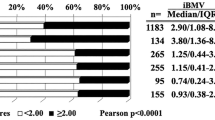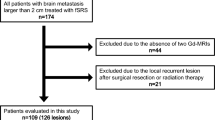Abstract
Purpose/objective(s)
Brain metastasis velocity (BMV) is a metric that describes the rate of development of new brain metastases (BM) after initial stereotactic radiosurgery (SRS). A limitation in the application of BMV is it cannot be applied until time of first BM failure after SRS. We developed initial BM velocity (iBMV), a new metric that accounts for the number of BM at first SRS and the time since initial cancer diagnosis.
Materials/methods
We reviewed patients with BM treated at our institution with upfront SRS without WBRT. iBMV was calculated as the number of BM at initial SRS divided by time (years) from initial cancer diagnosis to first SRS. We performed a linear regression to correlate BMV as a continuous variable and with low, intermediate, and high BMV risk groups. Kaplan–Meier estimation of OS was calculated from time of first SRS to death. iBMV was not calculated for patients who presented with BM at initial cancer diagnosis.
Results
994 patients were treated with upfront SRS without WBRT between 2000 and 2017. Median OS was 8.5 mos. 595 (60%) patients developed BM after cancer diagnosis and median time to first SRS from time of initial diagnosis was 2.2 years. Median iBMV was 0.79 BM/year. iBMV correlated with BMV (β = 1.57 p = 0.021) and independently predicted for mortality [Cox proportional hazard ratio (HR) 1.11, p = 0.036] after accounting for histology, number of initial brain metastases (HR 1.03, p = 0.32), time from cancer diagnosis to SRS (HR 0.98, p = 0.157) in a multivariate model.
Conclusion
iBMV correlates with BMV and OS. With further validation, iBMV could serve as a metric to risk stratify patients for WBRT or SRS at time of first BM presentation.


Similar content being viewed by others
References
Ellis TL, Neal MT, Chan MD (2012) The role of surgery, radiosurgery and whole brain radiation therapy in the management of patients with metastatic brain tumors. Int J Surg Oncol 2012:952345
Brown PD, Jaeckle K, Ballman KV et al (2016) Effect of radiosurgery alone vs radiosurgery with whole brain radiation therapy on cognitive function in patients with 1 to 3 brain metastases: a randomized clinical trial. JAMA 316:401–409
Soffietti R, Kocher M, Abacioglu UM et al (2013) A European Organisation for Research and Treatment of Cancer phase III trial of adjuvant whole-brain radiotherapy versus observation in patients with one to three brain metastases from solid tumors after surgical resection or radiosurgery: quality-of-life results. J Clin Oncol 31:65–72
Kocher M, Soffietti R, Abacioglu U et al (2011) Adjuvant whole-brain radiotherapy versus observation after radiosurgery or surgical resection of one to three cerebral metastases: results of the EORTC 22952–26001 study. J Clin Oncol 29:134–141
Aoyama H, Shirato H, Tago M et al (2006) Stereotactic radiosurgery plus whole-brain radiation therapy vs stereotactic radiosurgery alone for treatment of brain metastases: a randomized controlled trial. JAMA 295:2483–2491
Chang EL, Wefel JS, Hess KR et al (2009) Neurocognition in patients with brain metastases treated with radiosurgery or radiosurgery plus whole-brain irradiation: a randomised controlled trial. Lancet Oncol 10:1037–1044
Shen C, Lin DDM, Redmond KJ et al (2016) Imaging and clinical profile following concurrent stereotactic radiation and immune therapy for melanoma brain metastases: preliminary results. Int J Radiat Oncol Biol Phys 96:E134
Williams NL, Kim H, Eldredge-Hindy HB et al (2016) Phase I study of ipilimumab combined with whole-brain radiation therapy or radiosurgery for melanoma patients with brain metastases. Int J Radiat Oncol Biol Phys 96:S179
Lester SC, Taksler GB, Kuremsky JG et al (2014) Clinical and economic outcomes of patients with brain metastases based on symptoms: an argument for routine brain screening of those treated with upfront radiosurgery. Cancer 120:433–441
Ayala-Peacock DN, Peiffer AM, Lucas JT et al (2014) A nomogram for predicting distant brain failure in patients treated with gamma knife stereotactic radiosurgery without whole brain radiotherapy. Neuro Oncol 16:1283–1288
Farris M, McTyre E, Hughes RT et al (2016) Brain metastasis velocity: a novel prognostic metric predictive of overall survival and freedom from whole-brain radiation therapy after upfront radiosurgery alone for brain metastases. Int J Radiat Oncol Biol Phys 96:S180
McTyre ER, Johnson AG, Ruiz J et al (2016) Predictors of neurologic and nonneurologic death in patients with brain metastasis initially treated with upfront stereotactic radiosurgery without whole-brain radiation therapy. Neuro Oncol 19:558–566
Lucas JT, Colmer HG, White L et al (2015) Competing risk analysis of neurologic versus nonneurologic death in patients undergoing radiosurgical salvage after whole-brain radiation therapy failure: who actually dies of their brain metastases? Int J Radiat Oncol Biol Phys 92:1008–1015
Savitz ST, Chen RC, Sher DJ (2015) Cost-effectiveness analysis of neurocognitive-sparing treatments for brain metastases. Cancer 121:4231–4239
Farris M, McTyre ER, Cramer CK et al (2017) Brain metastasis velocity: a novel prognostic metric predictive of overall survival and freedom from whole-brain radiation therapy after distant brain failure following upfront radiosurgery alone. Int J Radiat Oncol Biol Phys 98:131–141
Roberge D, Brown P, Mason W et al (2017) Cmet-48. Ce7 Canadian Clinical Trials Group/Alliance for Clinical Trials in Oncology. A phase iii trial of stereotactic radiosurgery compared with whole brain radiotherapy (wbrt) for 5–15 brain metastases. Neuro Oncol 19:vi49
Tsao MN, Rades D, Wirth A et al (2012) International practice survey on the management of brain metastases: Third international consensus workshop on palliative radiotherapy and symptom control. Clin Oncol 24:e81–e92
Shaw E, Scott C, Souhami L et al (2000) Single dose radiosurgical treatment of recurrent previously irradiated primary brain tumors and brain metastases: final report of RTOG protocol 90-05. Int J Radiat Oncol Biol Phys 47:291–298
Sperduto PW, Kased N, Roberge D et al (2012) Summary report on the graded prognostic assessment: an accurate and facile diagnosis-specific tool to estimate survival for patients with brain metastases. J Clin Oncol 30:419–425
Sperduto PW, Jiang W, Brown PD et al (2017) Estimating survival in melanoma patients with brain metastases: an update of the graded prognostic assessment for melanoma using molecular markers (melanoma-molGPA). Int J Radiat Oncol Biol Phys 99:812–816
Ayala-Peacock DN, Attia A, Hepel J et al (2014) A multi-institutional predictive nomogram for distant brain failure in patients treated with upfront stereotactic radiosurgery without whole brain radiation therapy. Int J Radiat Oncol Biol Phys 90:S126
McTyre E, Farris M, Ayala-Peacock DN et al (2017) Multi-institutional validation of brain metastasis velocity, a recently defined predictor of outcomes following stereotactic radiosurgery. Int J Radiat Oncol Biol Phys 99:E93
Author information
Authors and Affiliations
Corresponding author
Ethics declarations
Conflict of interest
The authors declare that they have no competing interests.
Rights and permissions
About this article
Cite this article
Soike, M.H., McTyre, E.R., Hughes, R.T. et al. Initial brain metastasis velocity: does the rate at which cancers first seed the brain affect outcomes?. J Neurooncol 139, 461–467 (2018). https://doi.org/10.1007/s11060-018-2888-3
Received:
Accepted:
Published:
Issue Date:
DOI: https://doi.org/10.1007/s11060-018-2888-3




